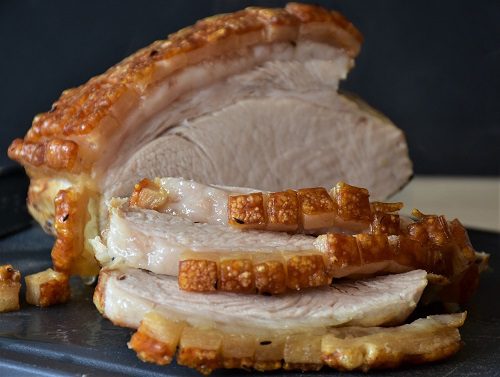Pork is one of the most commonly consumed meats worldwide. While it is a delicious protein source, it is also known to harbor parasites and bacteria that can cause foodborne illnesses if not cooked thoroughly.
One of the most significant risks associated with undercooked pork is the potential for trichinosis, a disease caused by the roundworm Trichinella spiralis, which can be fatal in severe cases. Hence, it’s crucial to cook pork to the recommended internal temperature to kill any harmful bacteria and parasites.
But what does undercooked pork look like? In this article, we will explore this question in-depth and provide you with some essential guidelines to ensure that your pork is cooked thoroughly and safe to eat.
Understanding the recommended cooking temperature for pork
Before we delve into the signs of undercooked pork, let’s first discuss the recommended internal temperature for cooking pork. The United States Department of Agriculture (USDA) recommends cooking pork to an internal temperature of at least 145°F (63°C) with a three-minute rest time. This temperature ensures that any harmful bacteria or parasites present in the meat are destroyed, making it safe to eat.

How to determine if pork is undercooked
One of the most reliable ways to determine if pork is undercooked is by checking its internal temperature with a meat thermometer. If the internal temperature of the pork has not reached the recommended 145°F (63°C), it is still undercooked and needs further cooking.
Apart from using a meat thermometer, there are other visual and tactile cues that you can use to determine if pork is undercooked. Undercooked pork tends to have a pinkish or reddish hue, which can be mistaken for rare meat.
However, unlike beef, pork should not be consumed rare, as it can harbor harmful parasites and bacteria that can cause severe health problems. Additionally, undercooked pork may appear moist, with a slightly mushy texture that makes it challenging to cut or chew.
Here are some signs that pork may be undercooked:
- Pinkish or reddish hue: Undercooked pork may still have a pinkish or reddish color, which can be mistaken for rare meat. However, unlike beef, pork should not be consumed rare, as it can harbor harmful parasites and bacteria.
- Moist texture: Undercooked pork may appear moist and have a slightly mushy texture, making it challenging to cut or chew.
- Blood or juice: If there is blood or juice seeping from the meat, it may indicate that it is undercooked.
- Soft or rubbery texture: Undercooked pork may have a soft or rubbery texture, which can be a sign that it has not been cooked thoroughly.
- Unpleasant odor: Undercooked pork may have an unpleasant odor, which can be a sign that it has not been cooked long enough to kill any harmful bacteria or parasites.

Risks associated with consuming undercooked pork
Consuming undercooked pork is associated with several health risks, primarily due to the presence of harmful bacteria and parasites. One of the most significant risks is trichinosis, a disease caused by the roundworm Trichinella spiralis, which can cause severe muscle pain, fever, and swelling of the eyelids.
In severe cases, trichinosis can even be fatal. Other bacteria that can be present in undercooked pork include Salmonella and E. coli, which can cause symptoms like nausea, vomiting, and diarrhea.
Safe handling and preparation of pork
To reduce the risk of foodborne illness associated with pork, it is essential to handle and prepare it safely. Here are some guidelines to follow:
- Wash your hands thoroughly with soap and warm water before and after handling raw pork.
- Use separate cutting boards and utensils for raw meat and other foods to prevent cross-contamination.
- Thaw frozen pork in the refrigerator or microwave, not at room temperature.
- Cook pork to the recommended internal temperature of 145°F (63°C) with a three-minute rest time.
- Refrigerate or freeze leftover pork promptly.

Tips for cooking pork thoroughly
To ensure that your pork is cooked thoroughly and safe to eat, here are some tips to keep in mind:
- Use a meat thermometer to check the internal temperature of the pork. Insert the thermometer into the thickest part of the meat, away from any bones or fat.
- Avoid overcooking the pork, as this can result in dry and tough meat. Once the pork has reached the recommended internal temperature, remove it from the heat source and allow it to rest for three minutes before carving or serving.
- If you’re cooking pork chops or tenderloin, consider using a cooking method that involves searing the meat before finishing it in the oven. This technique helps to seal in the juices and ensure that the pork is cooked evenly.
- Consider marinating the pork before cooking to add flavor and moisture to the meat. However, avoid using marinades that contain raw meat juices, as these can increase the risk of foodborne illness.
- If you’re grilling pork, use a meat thermometer to check the temperature of the meat regularly. The high heat of the grill can cause the outside of the pork to cook faster than the inside, resulting in undercooked meat.

Conclusion
Undercooked pork is a significant health risk that can lead to foodborne illnesses like trichinosis, Salmonella, and E. coli. To ensure that your pork is safe to eat, it’s essential to cook it to the recommended internal temperature of 145°F (63°C) with a three-minute rest time.
In addition to using a meat thermometer, you can also use visual and tactile cues to determine if the pork is undercooked. To reduce the risk of foodborne illness, follow safe handling and preparation guidelines and use cooking techniques that ensure the pork is cooked thoroughly and evenly.
By taking these precautions, you can enjoy delicious and safe pork dishes without the risk of foodborne illness.

